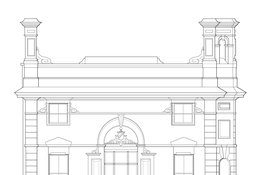Whitechapel Charities schools, Leman Street
Contributed by Johanna Roethe on May 31, 2017
A tender for the construction of schools in Leman Street mentions that the
architect was Mr Beck.[1] This might be William Beck (1823-1907), a Quaker
historian and architect, of London. In the 1860s and 1870s, Beck was in
partnership with William Ward Lee (as Beck & Lee). He was surveyor to Six
Weeks Meeting by 1862 and until c.1874, when he was succeeded by Lee who
continued his practice. Beck retired in 1876 and resigned his RIBA membership
in 1877. Beck & Lee designed hospitals in London and Saffron Walden,
Quaker meeting houses, the Quaker Bedford Institute, new buildings and
alterations for the British and Foreign School Society, and housing for the
Metropolitan Association for Improving the Dwellings of the Industrious
Classes, and the Improved Industrious Dwellings Company.
[1]: The Builder, 18 Oct 1856, p. 576
Whitechapel Charities’ Commercial School (demolished)
Contributed by Survey of London on July 31, 2020
The formation of the Charity Commissioners in 1853 led to the amalgamation of
Whitechapel’s parish charities and the building of the endowed Whitechapel
Charities’ Commercial School, a project championed by the Rev. William Weldon
Champneys, the pragmatically reforming Rector of St Mary Matfelon. Constructed
in 1856–7, this parochial school, aimed at the sons of tradesmen, was designed
by a Mr Beck, probably William Beck (1823–1907), a Quaker architect. The proud
five-bay palazzo front to Leman Street reflected the school’s ambitions.
Raised ground-floor and upper-storey schoolrooms were set above a granite
plinth perforated to light a basement playground. Steps led up to entrances on
Buckle Street.
The school opened in 1858 and its ‘commercial education’ soon gained high
regard. In 1861 it was said to be full with around 200 boys and scholarships
were strongly contested. By 1879 a large proportion of the pupils were Jewish,
and therefore exempt from New Testament exams.
A merger in 1888 of Whitechapel’s parish schools (the others being the
Davenant School on Whitechapel Road and St Mary’s School on St Mary Street) as
the Whitechapel Foundation caused the Leman Street building to be renamed the
Whitechapel Foundation Commercial School and to be adapted to be one of two
elementary schools serving a larger number of pupils as, confusingly, one of
the Davenant schools. But in an era with much wider educational provision and
a locality that was increasingly Jewish, this arrangement did not last. The
school closed in 1897, its pupils transferred to Whitechapel Road.
The building was thereafter converted to be the London Provident Dispensary,
founded by Herman Landau. He employed Yiddish-speaking doctors, hoping to
bring not only medical relief to the Jewish poor, but also knowledge of
hygiene and sanitation. He was, however, dissuaded from making the institution
wholly free to patients on account of fears of the pauperising effect it might
have on people served well by numerous local charities. The Young Zion
Institute made use of the building for lectures around 1902, and the East
London Progressive Club met here in 1911. A branch of the International Bank
of London had been set up on the premises by 1903 to serve as a ‘model
emigration bank’ to serve the many Jews still arriving in Whitechapel from
abroad. By 1932, the former school building was occupied by the Seamen’s
National Insurance Society. After the Second World War, it became a rag-trade
factory and warehouse. It was demolished around 2003.
City Reach, 19 Leman Street
Contributed by Survey of London on July 31, 2020
This building was erected in 2004–5 to designs by Osel Architecture Ltd for
Stronglink Ltd. The seven-storey block of offices and apartments, faced with
Portland stone and brick, replaced the former parish school and houses behind
at 24–26 Buckle Street. Its ground-floor retail units have remained unlet.
My favourite aunt
Contributed by Deekay on April 28, 2018
My great aunt, Doris Allan, was the second youngest from a dockworker's family
from Canning Town. I don't know where she learned her trade as an embroiderer
but she somehow worked her way up to owning her own business. She used to take
me with her to her workshop in Whitechapel. The first place was demolished as
it was very old and dilapidated but full of character and charm. She was on
the first floor and on the ground floor they made bags. I think they were
Italian? I remember the distinct smell of machine oil and cottons. After it
was pulled down, she moved to Alie Street and continued to work as an
embroiderer in to her 70s. Whitechapel was a part of my aunt's life as long as
I knew her and probably many years before. She moved out to Essex in the 1950s
but still commuted in every day - she must have had a real fondness for the
place.
